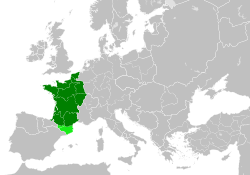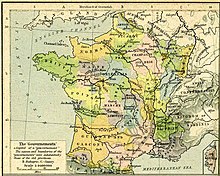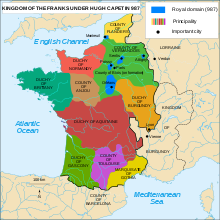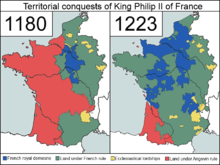Kingdom of France
Kingdom of France Reaume de France ( Latin ) | |||||||||||||||
|---|---|---|---|---|---|---|---|---|---|---|---|---|---|---|---|
| 987–1792 1814–1815 1815–1848 | |||||||||||||||
Motto:
| |||||||||||||||
 The Kingdom of France in 1000 | |||||||||||||||
 The Kingdom of France in 1789 | |||||||||||||||
| Capital |
| ||||||||||||||
| Largest city | Paris | ||||||||||||||
| Common languages |
| ||||||||||||||
| Religion |
| ||||||||||||||
| Demonym(s) | French | ||||||||||||||
| Government |
| ||||||||||||||
| Monarch | |||||||||||||||
• 987–996 | Hugh Capet (first) | ||||||||||||||
• 1830–1848 | Louis Philippe I (last) | ||||||||||||||
Charles-Maurice de Talleyrand | |||||||||||||||
• 1847–1848 | François Guizot | ||||||||||||||
| Legislature |
| ||||||||||||||
| |||||||||||||||
| |||||||||||||||
| Historical era | Early modern | ||||||||||||||
| c. 10 August 843 | |||||||||||||||
• Capetian dynasty established | 3 July 987 | ||||||||||||||
| 1337–1453 | |||||||||||||||
| 1562–1598 | |||||||||||||||
| 5 May 1789 | |||||||||||||||
| 21 September 1792 | |||||||||||||||
| 6 April 1814 | |||||||||||||||
| 2 August 1830 | |||||||||||||||
| 24 February 1848 | |||||||||||||||
| Currency | Livre, Livre parisis, Livre tournois, Denier, Sol/Sou, Franc, Écu, Louis d'or | ||||||||||||||
| ISO 3166 code | FR | ||||||||||||||
 Map of the first (light blue) and second (dark blue) French colonial empires. | |||||||||||||||
| |||||||||||||||
| History of France |
|---|
 |
| Topics |
| Timeline |
|
|
The Kingdom of France is the historiographical name or
The Kingdom of France was descended directly from the western Frankish realm of the Carolingian Empire, which was ceded to Charles the Bald with the Treaty of Verdun (843). A branch of the Carolingian dynasty continued to rule until 987, when Hugh Capet was elected king and founded the Capetian dynasty. The territory remained known as Francia and its ruler as rex Francorum ("king of the Franks") well into the High Middle Ages. The first king calling himself rex Francie ("King of France") was Philip II, in 1190, and officially from 1204. From then, France was continuously ruled by the Capetians and their cadet lines under the Valois and Bourbon until the monarchy was abolished in 1792 during the French Revolution. The Kingdom of France was also ruled in personal union with the Kingdom of Navarre over two time periods, 1284–1328 and 1572–1620, after which the institutions of Navarre were abolished and it was fully annexed by France (though the King of France continued to use the title "King of Navarre" through the end of the monarchy).
In the 16th to the 17th centuries, the First French colonial empire stretched from a total area at its peak in 1680 to over 10,000,000 square kilometres (3,900,000 sq mi), the second-largest empire in the world at the time behind the Spanish Empire. Colonial conflicts with Great Britain led to the loss of much of its North American holdings by 1763. French intervention in the American Revolutionary War helped the United States secure independence from King George III and the Kingdom of Great Britain, but was costly and achieved little for France.
France through its
Following the
Political history
West Francia
During the later years of
Viking incursions up the Loire, the Seine, and other inland waterways increased. During the reign of Charles the Simple (898–922), Vikings under Rollo from Scandinavia settled along the Seine, downstream from Paris, in a region that came to be known as Normandy.[8]
High Middle Ages
The
The old order left the new dynasty in immediate control of little beyond the middle Seine and adjacent territories, while powerful territorial lords such as the 10th- and 11th-century counts of Blois accumulated large domains of their own through marriage and through private arrangements with lesser nobles for protection and support.
The area around the lower Seine became a source of particular concern when Duke
Late Middle Ages and the Hundred Years' War
The death of
The losses of the century of war were enormous, particularly owing to the plague (the Black Death, usually considered an outbreak of bubonic plague), which arrived from Italy in 1348, spreading rapidly up the Rhône valley and thence across most of the country: it is estimated that a population of some 18–20 million in modern-day France at the time of the 1328 hearth tax returns had been reduced 150 years later by 50 percent or more.[12]
Renaissance and Reformation
The Renaissance era was noted for the emergence of powerful centralized institutions, as well as a flourishing culture (much of it imported from Italy).[13] The kings built a strong fiscal system, which heightened the power of the king to raise armies that overawed the local nobility.[14] In Paris especially there emerged strong traditions in literature, art and music. The prevailing style was classical.[15]
The Ordinance of Villers-Cotterêts was signed into law by Francis I in 1539. Largely the work of Chancellor Guillaume Poyet, it dealt with a number of government, judicial and ecclesiastical matters. Articles 110 and 111, the most famous, called for the use of the French language in all legal acts, notarised contracts and official legislation.
Italian Wars
After the Hundred Years' War,
Wars of Religion
Barely were the Italian Wars over, when France was plunged into a domestic crisis with far-reaching consequences. Despite the conclusion of a
The Wars of Religion culminated in the
Early modern period
Colonial France
France's pacification under Henry IV laid much of the ground for the beginnings of France's rise to European hegemony. France was expansive during all but the end of the seventeenth century: the French began trading in India and
Thirty Years' War
Henry IV's son
Administrative structures
The Ancien Régime, a French term rendered in English as "Old Rule", or simply "Former Regime", refers primarily to the aristocratic, social and political system of early modern France under the late Valois and Bourbon dynasties. The administrative and social structures of the Ancien Régime were the result of years of state-building, legislative acts (like the
Louis XIV, the Sun King
For most of the reign of
The king sought to impose total religious uniformity on the country, repealing the
In November 1700, King
Dissent and revolution

The reign (1715–1774) of
On the whole, the 18th century saw growing discontent with the monarchy and the established order. Louis XV was a highly unpopular king for his sexual excesses, overall weakness, and for losing New France to the British. A strong ruler like Louis XIV could enhance the position of the monarchy, while Louis XV weakened it. The writings of the philosophes such as Voltaire were a clear sign of discontent, but the king chose to ignore them. He died of smallpox in 1774, and the French people shed few tears at his death. While France had not yet experienced the Industrial Revolution that was beginning in Britain, the rising middle class of the cities felt increasingly frustrated with a system and rulers that seemed silly, frivolous, aloof, and antiquated, even if true feudalism no longer existed in France.
Upon Louis XV's death, his grandson Louis XVI became king. Initially popular, he too came to be widely detested by the 1780s. He was married to an Austrian archduchess, Marie Antoinette. French intervention in the American War of Independence was also very expensive.[25]
With the country deeply in debt, Louis XVI permitted the radical reforms of
Limited monarchy
On September 3, 1791, the absolute monarchy which had governed France for 948 years was forced to limit its power and become a provisional constitutional monarchy. However, this too would not last very long and on September 21, 1792, the French monarchy was effectively abolished by the proclamation of the French First Republic. The role of the King in France was finally ended with the Execution of Louis XVI by guillotine on Monday, January 21, 1793, followed by the "Reign of Terror", mass executions and the provisional "Directory" form of republican government, and the eventual beginnings of twenty-five years of reform, upheaval, dictatorship, wars and renewal, with the various Napoleonic Wars.
Restoration
Following the French Revolution (1789–99) and the First French Empire under Napoleon (1804–1814), the monarchy was restored when a coalition of European powers restored by arms the monarchy to the House of Bourbon in 1814. However the deposed Emperor Napoleon I returned triumphantly to Paris from his exile in Elba and ruled France for a short period known as the Hundred Days.
When a
However, the work of Louis XVIII was frustrated when, after his death on 16 September 1824, his brother the Count of Artois became king under the name of Charles X. Charles X was a strong reactionary who supported the ultra-royalists and the Catholic Church. Under his reign, the censorship of newspapers was reinforced, the Anti-Sacrilege Act passed, and compensations to Émigrés were increased. However, the reign also witnessed the French intervention in the Greek Revolution in favour of the Greek rebels, and the first phase of the conquest of Algeria.
The absolutist tendencies of the King were disliked by the Doctrinaire majority in the
Aftermath and July Monarchy

On 9 August 1830, the Chamber of Deputies elected
The conquest of Algeria continued, and new settlements were established in the Gulf of Guinea, Gabon, Madagascar, and Mayotte, while Tahiti was placed under protectorate.[33]
However, despite the initial reforms, Louis Philippe was little different from his predecessors. The old
The King tried to suppress the opposition with censorship, but when the Campagne des banquets ("Banquets' Campaign") was repressed in February 1848,[35] riots and seditions erupted in Paris and later all France, resulting in the February Revolution. The National Guard refused to repress the rebellion, resulting in Louis Philippe abdicating and fleeing to England. On 24 February 1848, the monarchy was abolished and the Second Republic was proclaimed.[36] Despite later attempts to re-establish the Kingdom in the 1870s, during the Third Republic, the French monarchy has not restored.
Territories and provinces



Before the 13th century, only a small part of what is now France was under control of the Frankish king; in the north there were Viking incursions leading to the formation of the
Territories inherited from Western Francia:
- Domain of the Frankish king (royal domain or demesne, see crown lands of France)
- Direct vassals of the French king in the 10th to 12th centuries:
- County of Champagne (to the royal domain in 1316)
- County of Blois (to the royal domain in 1391)
- Duchy of Burgundy (until 1477, then divided between France and the Habsburgs)
- County of Flanders (to Burgundy in 1369)
- Duchy of Bourbon (1327–1523)
Acquisitions during the 13th to 14th centuries:
- Duchy of Normandy (1204)
- County of Tourain(1204)
- County of Anjou (1225)
- County of Maine(1225)
- County of Auvergne(1271)
- County of Toulouse (1271), including:
- County of Quercy
- County of Rouergue
- County of Gevaudan
- Viscounty of Albi
- Marquisat of Gothia
- County of Champagne (to the royal domain in 1316)
- Dauphiné (1349), hereditary possession of the kings of France, to be held by the heir apparent, but technically not part of the kingdom of France because it remained nominally part of the Holy Roman Empire.
- County of Blois (to the royal domain in 1391)
Acquisitions from the Plantagenet kings of England with the French victory in the Hundred Years' War 1453
- Duchy of Aquitaine (Guyenne), including:
- County of Poitou
- County of La Marche
- County of Angoulême
- County of Périgord
- County of Velay
- County of Saintonge
- Viscounty of Limousin
- Lordship of Issoudun
- Lordship of Déols
- Duchy of Gascogne (Gascony)
- County of Agenais
- Duchy of Bretagne (disputed since the War of the Breton Succession, to France in 1453, to the royal demesne in 1547)
Acquisitions after the end of the Hundred Years' War:
- Duchy of Burgundy (1477)
- Pale of Calais (1558)
- Kingdom of Navarre (1620)
- Treaty of Nijmegen, Truce of Ratisbon(1684)
- County of Artois (1659)
- Roussillon and Perpignan, Montmédy and other parts of Luxembourg, parts of Flanders, including Arras, Béthune, Gravelines and Thionville (Treaty of the Pyrenees 1659)
- Free County of Burgundy(1668, 1679)
- French Hainaut (1679)
- Principality of Orange (1713)
- Duchy of Lorraine (1766)
- French conquest of Corsica (1769)
- Comtat Venaissin (1791)
Religion

Prior to the
During the Protestant Reformation of the mid 16th century, France developed a large and influential Protestant population, primarily of
Jews have a documented presence in France since at least the early Middle Ages.[43] The Kingdom of France was a center of Jewish learning in the Middle Ages, producing influential Jewish scholars such as Rashi and even hosting theological debates between Jews and Christians. Widespread persecution began in the 11th century and increased intermittently throughout the Middle Ages, with multiple expulsions and returns.[44]
Fundamental laws
See also
- Economic history of France
- Family tree of French monarchs
- Fundamental laws of the Kingdom of France
- Integration of Normandy into the royal domain of the Kingdom of France
Notes
References
- ISBN 9780521257640– via Google Books.
- ^ R.R. Palmer; Joel Colton (1978). A History of the Modern World (5th ed.). p. 161.
- ^ Aldrich, Robert (1996). Greater France: A History of French Overseas Expansion. p. 304.
- ISBN 9781576073353 – via Google Books.
- ^ Englund, Steven (2005). Napoleon: A Political Life. Harvard University Press. p. 254.
- ^ Englund, Steven (2005). Napoleon: A Political Life. Harvard University Press. p. 254.
- ISBN 9780521844802.
- .
- ISBN 9780824044442.
- ^ Peter Shervey Lewis, Later medieval France: the polity (1968).
- ^ Alice Minerva Atkinson, A Brief History of the Hundred Years' War (2012)
- ISBN 9780313332975.
- ^ James Russell Major, Representative Institutions in Renaissance France, 1421–1559 (1983).
- ^ Martin Wolfe, The fiscal system of renaissance France (1972).
- ^ Yarrow, Philip John (1974). A literary history of France: Renaissance France 1470–1589.; Zerner, Henri (2003). Renaissance art in France: the invention of classicism. Flammarion.
- ^ Holt, Mack P. (2005). The French wars of religion, 1562–1629.
- ISBN 9780044456353.
- ^ Peter H. Wilson, Europe's Tragedy: A History of the Thirty Years' War (2009).
- ^ Beik, William (2000). Louis XIV and Absolutism: A Brief Study with Documents.
- ISBN 9781847884633.
- ISBN 9782753531307.
- ISBN 9781349014705.
- ^ a b Daniel Roche, France in the Enlightenment (1998)
- ^ Colin Jones, The Great Nation: France from Louis XV to Napoleon (2003)
- ^ William Doyle, The French Revolution: A Very Short Introduction (2001)
- ^ Sylvia Neely, A Concise History of the French Revolution (2008)
- ^ Actes du congrès – vol. 3, 1961, p. 441.; Emmanuel de Waresquiel, 2003, pp. 460–461.
- ^ Duc de Dolberg, Castellan, II, 176 (letter 30 April 1827)
- ^ Mansel, Philip, Paris Between Empires (St. Martin Press, New York 2001) p. 245.
- Imprimerie nationale. 1831.
- ^ Michel Pastoureau (2001). Les emblèmes de la France. Bonneton. p. 223.
- ^ Barjot, Dominique; Chaline, Jean-Pierre; Encrevé, André (2014). La France au xixe siècle. Presses Universitaires de France. p. 656.
- ^ Barjot, Chaline & Encrevé (2014), pp. 232, 233.
- ^ Barjot, Chaline & Encrevé (2014), p. 202.
- ^ Barjot, Chaline & Encrevé (2014), pp. 211, 2012.
- ^ Barjot, Chaline & Encrevé (2014), pp. 298, 299.
- ISBN 9789733203162.
- ^ Parisse, Michael (2005). "Lotharingia". In Reuter, T. (ed.). The New Cambridge Medieval History: c. 900–c. 1024. Vol. III. Cambridge, UK: Cambridge University Press. pp. 313–315.
- ^ "Christian Majesty, His Most".
- ^ Wolfe, M. (2005). Jotham Parsons. The Church in the Republic: Gallicanism and Political Ideology in Renaissance France. Washington, D.C.: Catholic University of America Press. 2004. pp. ix, 322. The American Historical Review, 110(4), 1254–1255.
- ^ Hans J. Hillerbrand, Encyclopedia of Protestantism: 4-volume Set, paragraphs "France" and "Huguenots"; The Huguenot Population of France, 1600–1685: The Demographic Fate and Customs of a Religious Minority by Philip Benedict; American Philosophical Society, 1991, 164
- ^ Encyclopædia Britannica, 11th ed, Frank Puaux, "Huguenot"
- ISBN 0-486-42011-6.
- ^ Miller, Chaim (2013). "Rashi's Method of Biblical Commentary". chabad.org.
- ^ Dignat 2021.
Works cited
- Dignat, Alban (27 May 2021). Grégor, Isabelle (ed.). "XVIIe siècle : Absolutisme et monarchie en France" [17th century: Absolutism and Monarchy in France]. Herodote.net (in French). Herodote.net SAS. Retrieved 6 July 2023.
Further reading
- Beik, William. A Social and Cultural History of Early Modern France (2009) excerpt and text search
- Caron, François. An Economic History of Modern France (1979) online edition
- Doyle, William. Old Regime France: 1648–1788 (2001) excerpt and text search
- Duby, Georges. France in the Middle Ages 987–1460: From Hugh Capet to Joan of Arc (1993), survey by a leader of the Annales School excerpt and text search
- Fierro, Alfred. Historical Dictionary of Paris (1998) 392pp, an abridged translation of his Histoire et dictionnaire de Paris (1996), 1580pp
- Goubert, Pierre. The Course of French History (1991), standard French textbook excerpt and text search; also complete text online
- Goubert, Pierre. Louis XIV and Twenty Million Frenchmen (1972), social history from Annales School
- Haine, W. Scott. The History of France (2000), 280 pp. textbook. and text search; also online edition
- Lucien Edward Henry (1882). "Wikidata Q107258901.
- Holt, Mack P. Renaissance and Reformation France: 1500–1648 (2002) excerpt and text search
- Jones, Colin, and Emmanuel Le Roy Ladurie. The Cambridge Illustrated History of France (1999) excerpt and text search
- Jones, Colin. The Great Nation: France from Louis XV to Napoleon (2002) excerpt and text search
- Jones, Colin. Paris: Biography of a City (2004), 592pp; comprehensive history by a leading British scholar excerpt and text search
- Le Roy Ladurie, Emmanuel. The Ancien Régime: A History of France 1610–1774 (1999), survey by leader of the Annales School excerpt and text search
- Potter, David. France in the Later Middle Ages 1200–1500, (2003) excerpt and text search
- Potter, David. A History of France, 1460–1560: The Emergence of a Nation-State (1995)
- Price, Roger. A Concise History of France (1993) excerpt and text search
- Raymond, Gino. Historical Dictionary of France (2nd ed. 2008) 528pp
- Roche, Daniel. France in the Enlightenment (1998), wide-ranging history 1700–1789 excerpt and text search
- Wolf, John B. Louis XIV (1968), the standard scholarly biography online edition
Historiography
- Gildea, Robert. The Past in French History (1996)
- Nora, Pierre, ed. Realms of Memory: Rethinking the French Past (3 vol, 1996), essays by scholars; excerpt and text search; vol 2 excerpts; vol 3 excerpts
- Pinkney, David H. "Two Thousand Years of Paris", Journal of Modern History (1951) 23#3 pp. 262–264 in JSTOR
- Revel, Jacques, and Lynn Hunt, eds. Histories: French Constructions of the Past (1995). 654pp, 64 essays; emphasis on Annales School
- Symes, Carol. "The Middle Ages between Nationalism and Colonialism", French Historical Studies (Winter 2011) 34#1 pp 37–46
- Project MUSE
External links
 Media related to Kingdom of France at Wikimedia Commons
Media related to Kingdom of France at Wikimedia Commons Quotations related to Kingdom of France at Wikiquote
Quotations related to Kingdom of France at Wikiquote Kingdom of France travel guide from Wikivoyage
Kingdom of France travel guide from Wikivoyage



